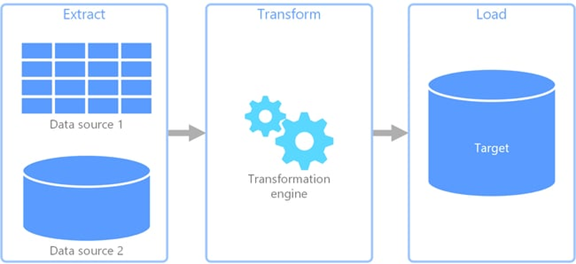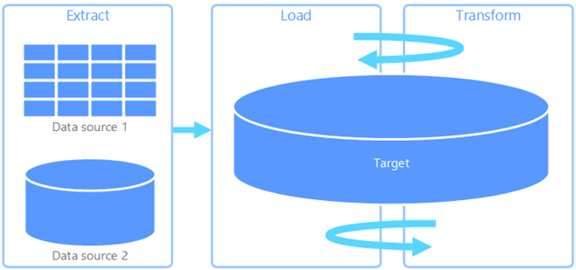Extract, Transform, and Load (ETL) and Extract, Load, and Transform (ELT) are the two most popular techniques for getting data from single or several sources into a centralized system for simple access and analysis.
Both ETL and ELT use extract, transform, and load phases to compile data. The difference lies in the sequence of events. Though you might assume that a small modification to the order of the phases wouldn’t matter, in fact it drastically alters how the integration process flows.
In short, ETL processes data from multiple sources and then loads it into a single database, while ELT waits until after it has been loaded to process it, allowing it to be transformed multiple times as needed.
What Is Extract, Transform, Load (ETL)?
ETL is a method of data integration that enables businesses to gather data from many sources and transfer it all to a single destination database. Three phases make up the ETL process: extraction, transformation, and loading.

- Extraction: Database queries or other data capture procedures are used to extract data from source systems, which might include software-as-a-service (SaaS), internet, on-premises, and more. The extracted data is then sent to a staging area.
- Transformation: Data is then prepared for consumption by a specific data warehouse, database, or data lake and put into a standard format so that a business intelligence platform such as Tableau or Looker can analyze it.
- Loading: The target system receives formatted data. This procedure may entail adding text to a delimited file, building database schemas, or developing new application object types.
What Is Extract Load Transform (ELT)?
ELT is a method of data integration that transmits data from a source system to a destination system without subjecting the data to business logic-driven changes. Three steps make up the ELT procedure: extraction, loading, and transformation.

- Extraction: Various sources, such as apps, SaaS, or databases, are used to extract raw data.
- Loading: Direct data delivery to the destination system is conducted, and the procedure usually includes schema and data type transformation.
- Transformation: The data can then be transformed for reporting purposes by the target platform. Some businesses use technologies like dbt to convert the target.
ETL vs. ELT: Similarities
In both ETL and ELT techniques, businesses may combine data from several databases into a single data repository where it can be prepared and qualified appropriately.
For analysis and further processing, this integrated data repository offers streamlined access.
Furthermore, it provides a single source of truth, guaranteeing that all enterprise data is accurate and current.
ETL vs. ELT: Differences
Despite what appears to be a minor change in process, there are far more differences between ETL and ELT than similarities. The following table breaks down the differences:
| Parameters | ETL | ELT |
| Process | The staging server transforms data, which is subsequently transmitted to the data warehouse (DWH) | Data continues to exist untransformed in the DWH |
| Code Usage | Applied to small amounts of data or computationally demanding transformations | Applied to large data sets |
| Load Time | A lengthy process where data is first loaded into the staging server and then loaded to the target system | A faster process where data is loaded once into the target system |
| Transformation Sequence | Transformations are carried out in the staging area of the ETL server | Transformations are carried out in the target system |
| Transformation Time | Load process will have to wait until the transformation is completed. This increases data size and transformation time | Speed will never depend on the size of the data in the ELT process |
| Maintenance Time | High maintenance time is required to load and transform the data | Data is always available in ELT, so low maintenance time is required |
| Implementation Complexity | Easier to implement at an early stage | Deep knowledge of tools and expertise are required to implement the ELT |
| Support for DWH | Used for structured and relational data and on-premises infrastructures | Used for structured and unstructured data in a scalable cloud architecture |
| Data Lake Support | Not supported | Utilizes unstructured data in the Data Lake |
| Complexity | Loads the crucial data that was determined at design time | Development is done using the output backwards, and only related data is loaded |
| Cost | Expensive for small and medium-sized enterprises | Online SaaS platforms keep costs low |
| Lookups | The staging area must have both facts and dimensions available | Because extract and load happen in a single event, all data will be available |
| Aggregations | Complexity increases with additional data added to the dataset | The target platform can process a considerable volume of data quickly |
| Hardware | Could be expensive with the unique hardware requirements of the tools | The cost of SaaS hardware is not a concern |
| Support for Unstructured Data | Relational data is mostly supported | Supports unstructured data |
ETL vs. ELT: Pros and Cons
Both ETL and ELT have some advantages and disadvantages depending on your corporate network’s size and needs. In general, ETL is a stalwart process with strong compliance protocols that suffers in speed and flexibility, while ELT is a relative newcomer that excels at rapidly migrating a large data set but lacks the dependability and security of its predecessor.
ETL Pros
The advantages of ETL include faster analysis, environmental flexibility, dependable compliance, and model maturity.
- Faster Analysis: Data queries are more efficient once ETL structures and transforms the data, which leads to faster analysis at the endpoint.
- Environmental Flexibility: ETL can be applied in either on-premises or cloud-based infrastructures.
- Compliance: Since ETL transforms data before sending it to the staging area, it enables organizations that must comply with data privacy laws like GDPR to delete, mask, or encrypt critical data before loading it into the DWH.
- Maturity: The ETL model has been in operation for the past two decades. This history means more engineers with ETL implementation experience are available, and there are more ETL tools available for building data pipelines within enterprises.
ETL Cons
Disadvantages of ETL include slow loading speeds, an inflexible workflow, and bogging down at high data volumes.
- Loading Speed: Data is not available in the datastore as rapidly as it is with ELT, since it must be converted in a staging area before being loaded, in contrast to ELT where it is loaded immediately after being extracted.
- Rigidity of Workflow: It may be necessary to modify the DWH’s transformation process and schema if the data warehouse’s structure does not enable new queries or analyses that are considered to be beneficial.
- Data Volume: Given the time required for transformation, ETL is not the best method for managing large amounts of data. Instead, smaller data sets that need intricate processing and are known to include information useful for analysis are best suited for it.
ELT Pros
The advantages of ELT include flexibility of data formats and transformation timing, as well as the speed of loading and implementing data.
- Flexibility of Data Formats: ELT may ingest data in any format when used with a data lake. Given that the data lake only takes unstructured data, structures and schema should not be taken into consideration.
- Transformation as Needed: In an ELT architecture, transformation occurs only when the analysis is necessary rather than before all data is loaded, resulting in higher resource efficiency.
- High Availability of Data: All of the data is placed into the data lake via ELT, making it continuously accessible. Rather than having to wait for the data to be transformed, this enables tools that don’t need structured data to interact with the imported data instantly.
- Speed of Loading: Data is fed into the data lake as soon as it becomes available since transformation occurs “at rest,” enabling quick access to information.
- Speed of Implementation: The ELT approach may be used to quickly gather data from new sources and store it in the data lake, since the transformation is performed as needed. This allows data engineers to figure out the optimal methods for data querying and analysis.
ELT Cons
Despite its many advantages, ELT is a newer approach than ETL and may run up against some compliance and compatibility issues.
- Compliance: Even if the sensitive material is deleted during a later transformation, regulations may forbid businesses from keeping it on file. Since certain laws forbid the storage of data on servers outside of a certain region or nation’s boundaries, integrating ELT with the cloud may provide a second problem.
- Newer Approach: Although ELT isn’t new technology, it is a cloud-native process and therefore more recent than ETL. While it’s beginning to see increased adoption, it still lags behind ETL in familiarity and widespread practicability.
- Environmental Flexibility: Though theoretically feasible in an on-premises setting, the real benefits of ELT are only available when combined with the cloud’s storage and processing capability.
- Speed of Analysis: ELT may prolong the time to insight for reviewing large amounts of unstructured data since transformation only occurs after the material has been imported and analysis is necessary. But the computational power offered by the cloud can moderate this.
ETL vs. ELT: Which One Should You Choose?
ETL and ELT each have particular uses for the data integration you may be trying to accomplish. Various aspects, like the data you have, the kind of storage you use, and the long-term requirements of your organization, might influence your decision regarding the best option for you.
Data quality and integrity will both be increased by the ETL and ELT techniques. Data structure for deeper analysis and investigation is the biggest strength of ETL, whereas speed and support for a variety of data types are the major strengths of ELT.
The goal is to weigh the benefits and disadvantages of both systems against your own needs to determine which one best suits the data management requirements and procedures of your organization. Either will remove annoying data silos and provide visibility throughout the organization.

